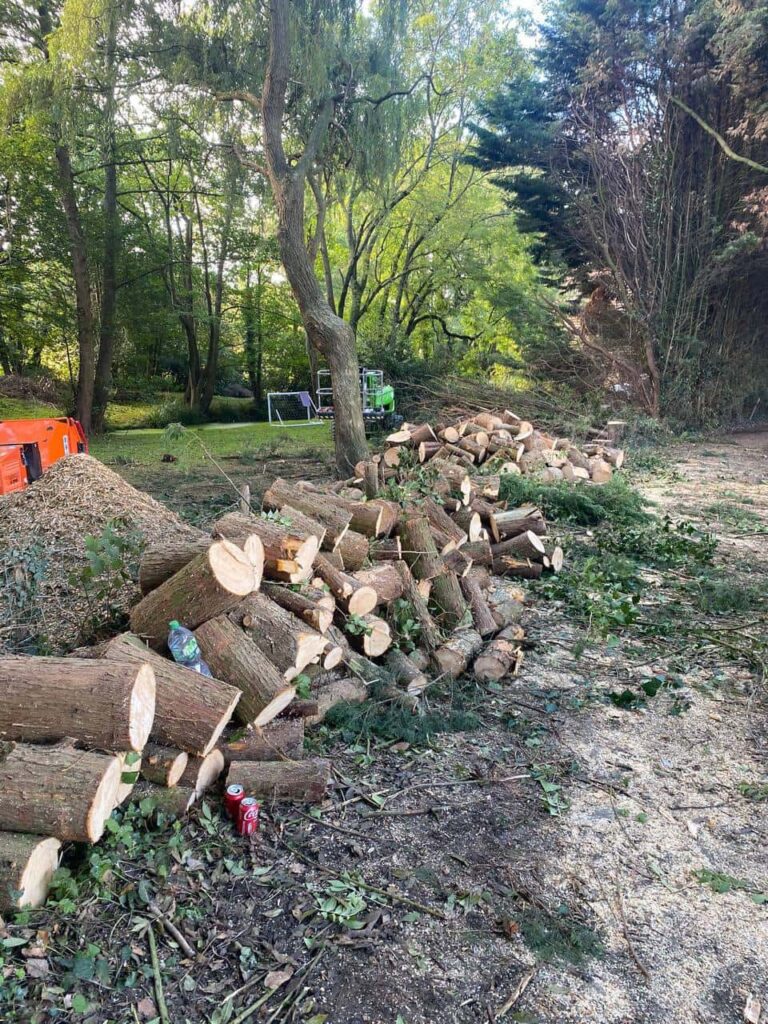Tree roots are vital to a tree’s stability and health, but when they spread too close to buildings or underground structures, they can cause serious issues such as subsidence. This is when the ground beneath a property begins to sink or shift, often leading to cracks in walls, uneven floors, and long-term structural damage.
At Lakenheath Tree Surgeons, we often help property owners in Lakenheath and across Suffolk identify and manage root-related problems before they lead to costly damage. Understanding how roots behave and how professional tree surgery can control their impact is key to keeping both your trees and your property safe.
What Causes Subsidence from Tree Roots?
Subsidence occurs when the soil beneath a structure loses moisture and shrinks, causing the foundations to move or settle unevenly. Certain types of soil, particularly clay-based soils found in parts of Suffolk, are more prone to this problem because they expand when wet and contract when dry.
Tree roots contribute to subsidence when:
- They extract large amounts of water from the soil, drying it out faster than it can be replenished.
- They grow too close to foundations, physically disturbing the ground structure.
- They seek moisture during dry periods, spreading deeper or wider and exacerbating instability beneath nearby buildings.
Not all trees pose a risk, but species such as willow, oak, poplar, and sycamore are known for having extensive, moisture-hungry root systems.
Signs That Tree Roots Are Causing Problems
Homeowners should remain alert to early signs of subsidence or root-related issues. Common indicators include:
- Cracks in exterior or interior walls, especially around doors and windows.
- Uneven floors or sinking patios.
- Doors or windows that begin to stick or jam.
- Visible root growth close to the base of walls, fences, or driveways.
- Trees leaning unusually or showing signs of stress due to soil movement.
If you notice one or more of these signs, it’s important to act quickly. A professional assessment from Lakenheath Tree Surgeons can help determine whether tree roots are the cause and what action should be taken.
How Tree Surgery Helps Prevent Subsidence
Professional tree surgery offers several effective methods to manage root growth and reduce the risk of subsidence without necessarily removing the tree altogether.
1. Controlled Root Pruning
Root pruning involves selectively trimming problematic roots that are growing too close to buildings or utilities. This must be done carefully to avoid destabilising the tree or causing excessive stress. Our team at Lakenheath Tree Surgeons assesses each tree individually to ensure pruning is performed safely and strategically.
2. Crown Reduction
By reducing the size of a tree’s canopy, crown reduction helps limit the amount of water the tree draws from the soil. With less foliage, the overall demand for moisture decreases, easing pressure on surrounding soil and reducing the likelihood of subsidence.
3. Species-Specific Management
Different tree species behave differently when it comes to root spread and water uptake. Professional arborists can identify high-risk trees and recommend appropriate management, such as phased reductions or replanting with less invasive species.
4. Root Barriers and Containment
In some cases, installing physical barriers in the ground can prevent roots from encroaching on sensitive areas. These barriers guide root growth away from foundations or paved surfaces while still allowing the tree to remain healthy.
5. Regular Monitoring and Maintenance
Routine inspections are crucial for early detection of root-related movement or soil shifts. Regular maintenance by skilled tree surgeons ensures trees remain stable, healthy, and appropriately distanced from buildings or drainage systems.
Why Professional Tree Management Matters
Attempting to cut back or remove tree roots without proper knowledge can lead to unintended consequences such as destabilisation, disease, or even tree failure. Professional tree surgeons have the expertise and equipment to manage root systems safely and sustainably.
At Lakenheath Tree Surgeons, we combine years of local experience with a deep understanding of how soil conditions and tree growth patterns affect properties across Suffolk. Our approach focuses on preserving healthy trees while preventing avoidable structural problems.
Preventative Measures for Property Owners
Homeowners can take several steps to minimise the risks associated with tree roots and subsidence:
- Choose the right species when planting new trees, avoiding those with aggressive root systems near buildings.
- Maintain safe distances between trees and structures such as garages, patios, and drainage systems.
- Water trees during dry spells to help reduce excessive moisture extraction from surrounding soil.
- Book regular inspections with Lakenheath Tree Surgeons to ensure early signs of subsidence or root intrusion are detected.
The Long-Term Benefits of Proper Tree Care
Well-managed trees don’t just prevent damage — they also enhance the beauty, value, and environmental health of your property. Through professional pruning, root control, and ongoing maintenance, trees can continue to thrive safely for generations.
For homeowners in Lakenheath and the wider Suffolk area, Lakenheath Tree Surgeons provides expert root management and subsidence prevention services designed to protect both your home and your landscape.
Conclusion
Tree roots are essential for stability and growth, but when they interfere with a property’s foundations, they can cause serious damage. With professional tree surgery and proactive management, it’s entirely possible to prevent subsidence while maintaining healthy, attractive trees.
Lakenheath Tree Surgeons specialises in identifying, managing, and preventing root-related problems through skilled tree care. By addressing issues early, we help property owners in Lakenheath protect their homes and enjoy the long-term benefits of safe, sustainable tree growth.
Call us on: 01842 771 096
Click here to find out more about Lakenheath Tree Surgeons
Click here to complete our contact form and see how we can help with your tree needs.

